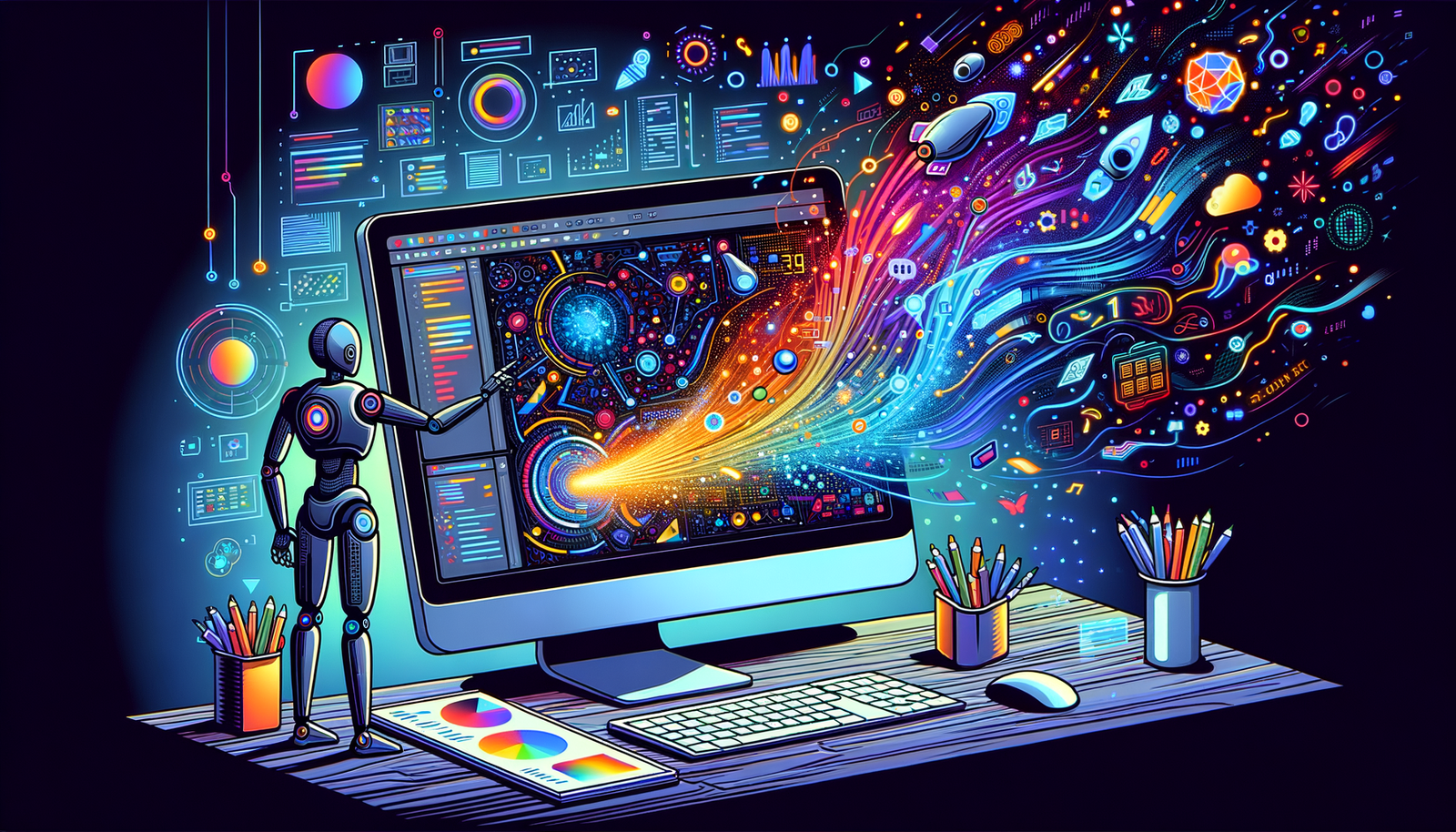Your Cart is Empty
Customer Testimonials
-
"Great customer service. The folks at Novedge were super helpful in navigating a somewhat complicated order including software upgrades and serial numbers in various stages of inactivity. They were friendly and helpful throughout the process.."
Ruben Ruckmark
"Quick & very helpful. We have been using Novedge for years and are very happy with their quick service when we need to make a purchase and excellent support resolving any issues."
Will Woodson
"Scott is the best. He reminds me about subscriptions dates, guides me in the correct direction for updates. He always responds promptly to me. He is literally the reason I continue to work with Novedge and will do so in the future."
Edward Mchugh
"Calvin Lok is “the man”. After my purchase of Sketchup 2021, he called me and provided step-by-step instructions to ease me through difficulties I was having with the setup of my new software."
Mike Borzage
Revolutionizing Design Software with AI and Data-Driven Insights
April 26, 2025 13 min read


Evolution in Design Software and Data-Driven Decisions
Over the past few decades, the landscape of design software has evolved dramatically, shifting from basic drafting tools to complex, multifaceted platforms that integrate real-time data and enable robust collaboration features. Early iterations of design applications were primarily focused on static representations and manual manipulations, but recent advances in computational power have given rise to software that not only facilitates design but also provides actionable insights derived from user interactions. This evolution is greatly influenced by the rise of big data and the imperative for data-driven decisions in every aspect of design workflows. The transformation has been partly driven by the explosion of data available from various sensors and digital touchpoints, enabling design professionals to leverage detailed analytics to understand user behavior, optimize workflows, and ultimately produce more user-centric and efficient systems. In today’s competitive market, organizations are increasingly relying on analytics to improve software interfaces and enhance design processes, ensuring that every decision is backed by empirical evidence rather than intuition alone. Analysts utilize a rich set of tools and methodologies aimed at capturing and interpreting usage patterns, which then inform updates and upgrades in the software lifecycle. The shift towards data-driven methodologies is not merely about adopting new technology—it represents a broader transition in mindset, where evidence and continuous feedback loops serve as the cornerstones for strategic improvements. This transition underscores the emerging paradigm in which every design decision is supported by cloud-based analytics, machine learning models, and real-time monitoring. The reliance on such comprehensive techniques highlights a future where the iterative nature of design work is enhanced through continuous integration and automated data comparison, bridging the gap between creative inputs and technical feasibility. With the integration of artificial intelligence into these systems, companies can sift through vast amounts of data to identify noteworthy patterns that set the stage for innovative solutions. As a result, the once distinctly separate worlds of creative design and rigorous analytics are increasingly converging, offering a robust environment where art meets science, and every detail, from minute user interactions to major design shifts, is measured, analyzed, and optimized for peak performance.
AI-Driven User Behavior Analytics in Modern Workflows
The integration of AI-driven user behavior analytics has introduced unprecedented improvements to modern design workflows, interconnecting the human factor with real-time computational insights. In current design software environments, artificial intelligence is deployed to track and interpret the nuances of how users interact with the interface, offering dynamic insights that traditional data analysis methods simply could not match. The methodology relies on advanced algorithms that sift through layers of user data—ranging from subtle navigation patterns to specific frequencies of tool usage—and distill this information into actionable insights. This innovative approach not only provides a deeper understanding of the user's journey but also enables rapid iteration of user-centric features. Modern platforms can automatically adjust to user preferences by analyzing historical data, enabling the software to serve content and tools in a manner that aligns with the user’s workflow pattern. These methodologies have transformed the concept of user experience into a quantifiable metric, where each click, scroll, and pause is recorded, analyzed, and turned into data that informs future design enhancements. As a result, tools are evolving into highly adaptive systems that outpace static product cycles, ensuring each update or new release is reflective of actual user trends. Such insights also facilitate the prediction of feature popularity and the identification of interface bottlenecks, driving a balanced approach between automation and user discretion. Moreover, designers are now better equipped to simulate various design scenarios, thereby aligning proposed changes with computed data—an advantage that is invaluable in iterative development cycles. The advanced cross-section of AI analytics and design interventions has created a feedback loop that is both efficient and highly adaptive, making it possible to achieve continuity in design evolution while maintaining the core values of creative expression and human-intuitive design choices.
Key Definitions and Terminologies in Analytics and AI
As the design community continues to embrace powerful analytics and intelligent systems, it becomes imperative to establish clear definitions and terminologies that underlie these transformative technologies. In the evolving lexicon of design software, terms such as machine learning, neural networks, predictive modeling, and user behavior analytics are increasingly commonplace. Machine learning, for instance, refers to the capability of computer systems to improve their performance on tasks over time without being explicitly programmed, drawing heavily on computational statistics and algorithms. Meanwhile, neural networks represent a subset of machine learning that mimics the interconnected structure of the human brain to solve complex problems like pattern recognition and data classification. User behavior analytics, a term specific to modern design processes, encapsulates the systematic study of how users interact with digital interfaces by capturing a myriad of data points ranging from basic navigational paths to deep engagement metrics. Understanding these terminologies is critical as they form the backbone of initiatives aimed at marrying design innovation with engineered precision. The concepts also include natural language processing for interpreting textual data, computer vision for analyzing visual inputs, and real-time data streaming that enables instantaneous processing and feedback. In practical scenarios, the integration of these technological advancements has led to the development of tools that routinely offer recommendations on layout optimizations, color schemes, and even user interface adjustments based on statistical inferences. Designers are now faced with a fascinating crossroads where the art of design and the science of data analysis converge, steering the industry towards a future where every design decision is informed by sophisticated computational insights. This shared understanding of core definitions ensures that teams across disciplines can speak a unified language, thus facilitating better collaboration, clearer communication, and ultimately more effective deployment of AI-enhanced tools in the design sphere.
Interpreting User Interactions Through AI Algorithms
One of the defining features of modern design software is its ability to harness AI algorithms to interpret a multitude of user interactions within the interface. Utilizing advanced statistical models, these systems are capable of discerning subtle patterns in the way a user navigates through complex toolsets, choosing certain functionalities over others. The process involves not only aggregating large volumes of data from multiple sources but also applying predictive algorithms that can forecast future user behaviors based on historical interactions. These algorithms analyze critical data points such as dwell time on particular tools, sequence of actions performed during project sessions, and even minor adjustments in settings or layouts. The resulting insights help developers refine software usability, making the tools feel more intuitive and responsive to the varying needs of its user base. In practice, this means that a system equipped with robust analytics can automatically rearrange icon placements, expand frequently used functions, or even suggest new features that complement the user's workflow patterns. The fusion of AI with user interaction data has laid the foundation for what many refer to as next-generation design software, where learning algorithms continually self-improve through each interaction. Some of the key factors that these algorithms evaluate include navigation consistency, time distribution across different tools, and response patterns to varying levels of software prompts or alerts. In delivering a more seamless user experience, such comprehensive data analysis fosters a personalized touch, ultimately leading users to interact with systems that are highly adaptive, reflective, and responsive. This strategic union of AI with actionable insights signifies a major shift towards more intelligent, user-tailored design environments, heralding a future where even the most complex applications simplify user interactions by preempting needs and augmenting creative processes in ways that were once considered impossible.
Examples and Data Points in User Behavior Analytics
When exploring the realm of AI-driven analytics, it is essential to examine how granular data points influence design applications in everyday use. At the core of this practice is the collection of comprehensive datasets capturing user behaviors, such as navigation patterns, frequencies of specific tool usage, and the dynamics of collaborative efforts during multi-user sessions. The collection and examination of these data points enable the analysis of recurring actions and the identification of potential friction points within the software environment. For instance, by leveraging insights from user navigation paths, developers are able to discern natural movement flows through the interface, leading them to reorganize toolbars and menus for optimized accessibility. Similarly, when assessing the frequency and duration of interactions with advanced features, it becomes possible to identify which platforms require reinforcement through enhanced guides or alternative user interface designs. In practice, a few bullet points that encapsulate the significant data points collected include:
- Navigation Patterns: Tracking the screen areas to which users frequently return.
- Tool Usage Frequency: Monitoring how often specialized tools are employed during projects.
- Collaboration Dynamics: Evaluating the interaction between multiple users and the communication channels used.
Benefits of Deep Analytics for Enhanced User Experience and Tool Development
The integration of deep analytics into design software has fostered transformative benefits that extend far beyond mere user data aggregation. By harnessing sophisticated algorithms and machine learning capabilities, designers and developers now have access to a wealth of insights that enable the creation of more intuitive, responsive, and personalized interfaces. One of the most pronounced benefits is the significant enhancement of the overall user experience. The data derived from meticulous user activity tracking is used not only to identify areas of potential friction, but also to suggest improvements and automate interface customization that aligns with individual user preferences. This leads to more fluid design processes where each layer of the software continuously evolves based on user interactions. The specific advantages include an improved understanding of user behavior, which in turn supports iterative tool development that is both data-informed and creatively driven. Moreover, deep analytics empower development teams to optimize resource allocation by highlighting which features warrant further enhancement and which might be deprecated in favor of more promising, user-centric designs. Such insights have proven invaluable in pinpointing critical improvements that lead to a reduction of cognitive load on the end-user and a subsequent boost in productivity. Some of the key benefits realized through this approach include:
- Enhanced personalization resulting in more intuitive design interfaces.
- Proactive feature adjustments based on empirical user data.
- Data-driven prioritization in software updates and tool integration.
Technical and Ethical Challenges in Analytics Integration
While the deployment of AI analytics within design software offers significant strategic advantages, it brings with it a myriad of technical and ethical challenges that must be addressed with a meticulous approach. One of the foremost technical hurdles involves the seamless integration of large-scale data processing without compromising system performance. The need for real-time analytics often demands high-speed computational resources and robust architectures capable of managing massive datasets. As such, engineers must design backend infrastructures that can scale effectively while ensuring minimal latency in data retrieval and processing. On the ethical front, concerns surrounding data privacy and user consent are paramount. Designers and developers face the delicate balancing act of capturing sufficient data to extract meaningful insights while ensuring that such data collection complies with global data protection regulations. Safeguarding sensitive information requires implementing comprehensive security measures, such as encryption, anonymization, and stringent access controls to prevent unauthorized data breaches. Furthermore, the integration of automated insights into creative workflows raises questions about the interplay between machine-based recommendations and organic human creativity. There is often a fine line between leveraging artificial intelligence to support decision-making and allowing it to incur unintended biases that might stifle inventive approaches. To navigate these challenges effectively, organizations are encouraged to adopt a transparent approach to data collection practices and utilize frameworks that prioritize user autonomy. Some of the key concerns and countermeasures include:
- Maintaining strict adherence to data privacy laws and ethical guidelines.
- Implementing state-of-the-art cybersecurity protocols to protect sensitive user information.
Strategies for Integrating AI Analytics into Existing Design Systems
Integrating AI analytics into longstanding design systems requires a strategic roadmap that aligns technical innovation with the core functionality of existing applications. A critical strategy is the comprehensive audit of current software architectures, where developers assess the available data streams and system functionalities before moving forward with the integration process. Maintaining the delicate balance between new and legacy components is essential to avoid disruption in user experience while simultaneously benefitting from the introduction of predictive insights. In practice, this calls for a layered approach: first, the identification of high-impact areas where the insertion of advanced analytics will yield immediate benefits, followed by incremental system upgrades that incorporate these new capabilities. Developers also focus on ensuring compatibility between traditional codebases and modern, AI-powered modules by leveraging frameworks that offer robust support for modular integration. Some of the methodologies involved include microservices architectures that facilitate updates without system-wide overhauls and flexible APIs that allow for seamless data exchanges between the legacy system and the new analytics modules. A further strategy involves continuous testing and iteration, where small, controlled releases are monitored closely for performance metrics and user feedback. These iterative cycles allow development teams to fine-tune the functionality, ensuring that new insights enhance rather than hinder the overall user workflow. Key strategies include:
- Incrementally adopting AI modules that integrate smoothly with existing infrastructures.
- Conducting extensive beta testing to gauge system response and performance improvements.
Future Opportunities: Adaptive Interfaces and Predictive Design Features
Looking ahead, the future of design software is set to be revolutionized by developments in adaptive interfaces and predictive design features, fueled by continuous advancements in artificial intelligence and machine learning. As these technologies mature, we are likely to witness the emergence of interfaces that dynamically adjust to each user’s unique behavioral patterns, creating a highly personalized work environment that reduces friction and enhances overall creativity. Adaptive interfaces will be characterized by their ability to learn from user interactions and modify layouts, shortcuts, and tool placements in real time based on historical usage data. Predictive design features, on the other hand, will leverage machine intelligence to forecast user needs before the requirements become explicit. These features have the potential to transform traditional design software from a reactive tool into a proactive assistant, capable of suggesting revisions or anticipating creative challenges even before the user is aware of them. The integration of such adaptive systems promises not only a more streamlined workflow but also a profound shift in how creative processes are managed in high-pressure environments. As users become more accustomed to technology that intuitively adapts to their methodologies, the standards of user experience will be redefined in unprecedented ways. This next generation of design software will likely incorporate feedback loops that harness real-time data, neural network predictions, and contextual references to create predictive models of design behavior. Some of the emerging opportunities in this space include:
- Interfaces that automatically reorganize based on user habits and project demands.
- Predictive features that anticipate user needs based on ongoing activity streams.
Summary and Conclusion
In conclusion, the integration of AI-driven user behavior analytics into design software is reshaping the industry by enabling a highly responsive and adaptive digital environment that centers on user needs and long-term innovation. From the early evolution of basic design tools to today’s sophisticated systems that incorporate real-time data analytics, the journey has been marked by significant technological advancements and an ever-deepening commitment to data-driven decision-making. The multiple layers of analysis provided by these advanced systems allow designers and developers to work in symbiosis, leveraging intricate patterns from detailed usage data to inform future tool development and streamline workflow processes. At the same time, the challenges posed by data privacy, system integration, and the balance between human creativity and machine insights call for meticulous planning and thoughtful responses, ensuring that new technology is coupled with ethical standards and robust engineering practices. The roadmap ahead offers exciting possibilities—from interfaces that adapt dynamically to user behaviors to predictive design features that offer proactive suggestions for improvements. Ultimately, embracing the innovative power of AI analytics fosters a more user-centric design environment that not only enhances creative workflows but also secures a sustainable competitive edge in an ever-evolving digital landscape. In moving forward, it is imperative that industry stakeholders invest in both technological advancement and ethical frameworks, creating solutions that are as secure as they are visionary, and nurturing a continuous cycle of innovation that benefits the entire design ecosystem.
Also in Design News

Revolutionizing Business: Integrating Design Software with ERP Systems for Seamless Innovation and Efficiency
August 27, 2025 10 min read
Read More
Cinema 4D Tip: Optimizing Polygon Count in Cinema 4D for Enhanced Performance and Visual Fidelity
August 27, 2025 3 min read
Read MoreSubscribe
Sign up to get the latest on sales, new releases and more …



